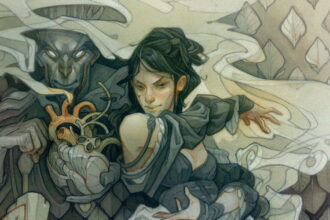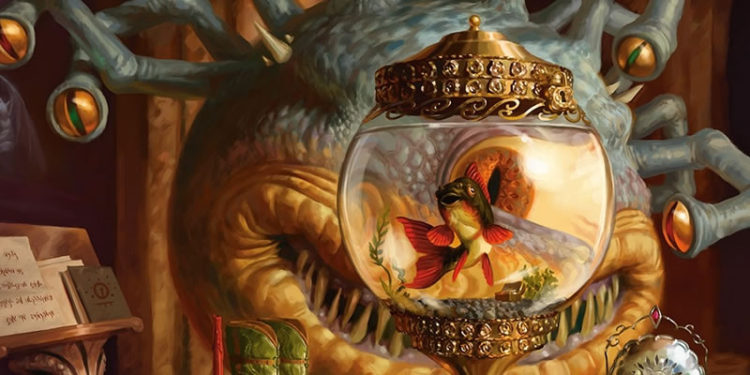
Explore a wealth of new rules options for both players and Dungeon Masters in this supplement for the world’s greatest roleplaying game.
Xanathar’s Guide to Everything is out now on D&D Beyond and at your FLGS (Friendly Neighborhood Gaming Stores). The book will be available everywhere else on November 21, 2017. For anyone who has been following the Unearthed Arcana articles, you’ll find lots of the content in this book, but revised and expanded (after playtests and feedback). This book also contains subclasses and spells that have already been published in other books such as Sword Coast Adventurer’s Guide and Princes of the Apocalypse. But never fear, there’s plenty of brand new content to enjoy too. The finished product comes together well, providing us with the first real expansion of D&D fifth edition ruleset.
I’ve had a chance to play test some of the rules and subclasses from this book over the last week. In this review I will outline what the book contains and provide my thoughts on who should purchase the book and who should maybe pass on this purchase.
A Quick Look at the Book…
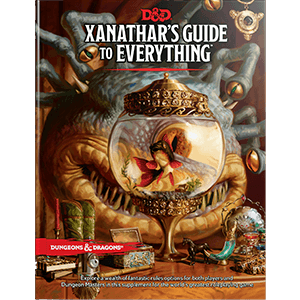
- Coming November 21, 2017 and the hardcover costs US$49.95 (C$65.95)
- Pre-Release to FLAGS November 10, 2017
- Available on D&D Beyond and Fantasy Grounds on November 10, 2017 and on Roll20 a little later.
- Format: Hardcover (and Digital)
- Lead Designers: Jeremy Crawford and Mike Mearls
- The short introduction reminds us that the Dungeon Master is the final authority on the rules and provides Ten Rules to Remember.
- Chapter 1 contains over twenty-five new subclasses for the character classes in the Player’s Handbook, including the Cavalier for the fighter, the Circle of Dreams for the druid, the Horizon Walker for the ranger, the Inquisitive for the rogue, and many more. You’ll also find tools to flesh out your character’s backstory and racial feats.
- Chapter 2 includes a variety Dungeon Master’s tools, providing fresh ways to use traps, magic items, downtime activities, and more—all designed to enhance a D&D campaign and push it in new directions.
- Chapter 3 provides dozens of new spells (and reprint of Elemental Evil spells), a collection of racial feats, and a system to give your character a randomized backstory.
- plus… throughout the book Xanathar provides fun and strange little notes on the content.
Hobby Store Exclusive
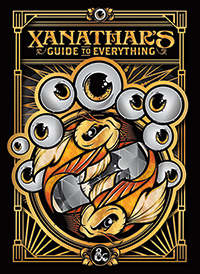 “Xanathar’s Guide to Everything also comes in a limited edition format, exclusive to core hobby stores, featuring an alternative-art cover, beautifully illustrated by Hydro74”
“Xanathar’s Guide to Everything also comes in a limited edition format, exclusive to core hobby stores, featuring an alternative-art cover, beautifully illustrated by Hydro74”
The decision to provide a limited edition cover to game stores is a really great way to push people towards their FLGS (Friendly Neighborhood Gaming Store) and away from Amazon, which is good for D&D’s organized play (Adventurers League) and the overall hobby.
Here is a shot of the exclusive cover to the right. I received a copy of the limited edition and it is very nice touch. The art looks excellent and the cover is less glossy than the regular edition. Do I like it better than the regular cover? Hmmmm.
CHAPTER 1: CHARACTER OPTIONS
In this chapter, you’ll find 31 subclasses (27 new, 4 reprints from Sword Coast Adventurer’s Guide) for the character classes in the Player’s Handbook (PHB), with many getting three brand new subclass options. You’ll also find some excellent optional tools to flesh out your character’s backstory in the form of random tables tied to your class and backstory. The chapter closes out with racial feats for all of the non-human races found in the PHB.
Barbarian
Barbarians can now add personal totems, tattoos and superstitions to their backstory. You’ll also find three brand new primal paths that include:
- The Ancestral Guardian calls on ancestors for power when raging and cover themselves in tattoos to celebrate their ancestor’s deeds.
- The Storm Herald represents barbarians who learn to channel their rage to harness powerful primal magic, emanating as a storm aura of desert, sea or tundra.
- The Zealot channels rage into powerful displays of divine power and follows a god focused on combat, destruction and violence.
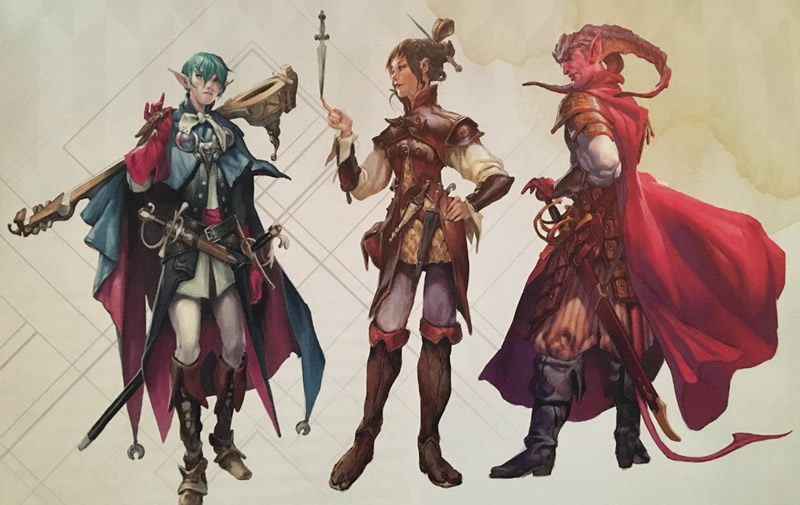
Bard
Bards are given inspiration for creating a defining work, finding the ultimate instrument, embarrassments and muses. Fans of the bard class will find three new colleges to play with:
- The College of Glamour is for bards who train in the Feywild (or with someone from there), learning to use their magic to delight and captivate their audience.
- The College of Swords is for blades, who are highly skilled warriors that show off their skills in combat and to entertain.
- The College of Whispers are bards that use their knowledge and magic to uncover secrets that are used to extort and threaten their way into power.
Cleric
Clerics are provided with guidance on choosing a temple, keepsake, and secret to add more detail for their character. Clerics are blessed with two new domains to choose from:
- The Forge Domain is for clerics who follow gods of the forge and are willing to craft and use heavy armor and powerful weapons to protect them.
- The Grave Domain provides an option to create clerics who watch over the line between life and death and worship deities of the grave.
Druid
Druids are provided with a treasured item, a guiding aspect, and a mentor. Druids have two new circles to select:
- The Circle of Dreams let’s players create druids with strong ties to the Feywild and its dreamlike qualities.
- The Circle of the Shepard is for druids who commune with the spirits of nature, protecting beasts and fey creatures and opposing forces who threaten them.
Druids also get two and a half pages of beast shape options, split up by biome and challenge rating.
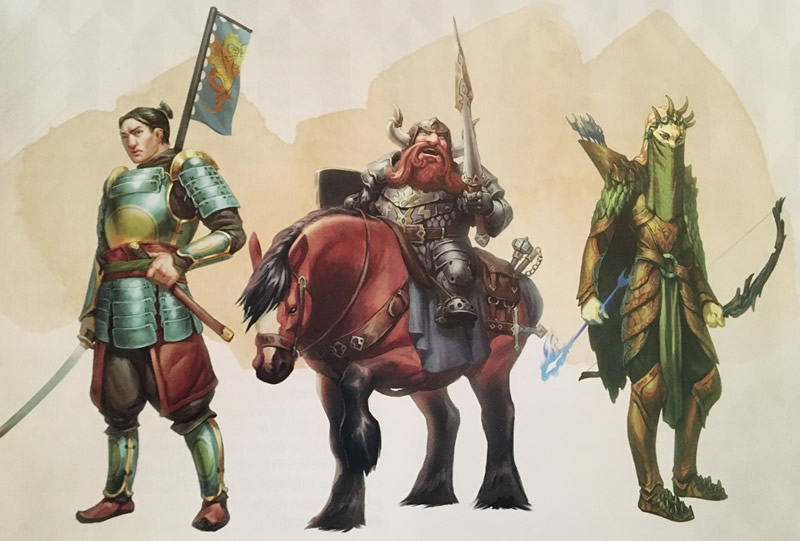
Fighter
Fighter backstories can be expanded with a heraldic sign, an instructor, and their own signature style. The fighter gets three new archetypes:
- The Arcane Archer use elven methods to weave magic into attacks to produce supernatural effects using magic arrows and arcane shots.
- The Cavalier excels equally at mounted combat and in the world of nobles. These shining knights earn prestige for righting wrongs and going on glorious adventures.
- The Samurai draw on their nearly unbreakable fighting spirit to take down any enemies in their path who do not yield.
Monk
Monks can add to their backstory by detailing their monastery, monastic icon, and master. Monks discover two new monastic traditions and a reprint of the Sun Soul:
- The Way of the Drunken Master teaches a monk to play the fool, using the unpredictable movement of a drunkard to disguise their skill, maddening opponents and bring laughter to everyone else.
- The Way of the Kensei is for monks who relentlessly train, until their weapons become an extension of their body.
- The Way of the Sun Soul (also in SCAG) is for monks who meditate and learn to channel their life energy into searing bolts of radiant light.
Paladin
Paladins can expand their character details with a personal goal, a symbol, a nemesis, and a temptation. The paladin gets two new Sacred Oaths:
- The Oath of Conquest is for paladins who seek glory in battle and wish to crush chaos and their enemies, even becoming tyrants.
- The Oath of Redemption sets a paladin on the path of a holy warrior, believing violence is a last resort and that anyone can be redeemed.
Ranger
Rangers are provided can generate their view of the world, homeland, and sworn enemy. Rangers are provided with three new archetypes:
- The Gloom Stalker is at home in the darkest places, seeking to ambush threats in the shadows before they reach the broader world.
- The Horizon Walker guard against threats from other planes looking to destroy that mortal realm, pursuing their foes across the planes.
- The Monster Slayer is your chance to play Van Helsing, hunting down vampires, dragons, fey and fiends using supernatural techniques to overcome these dangerous foes.
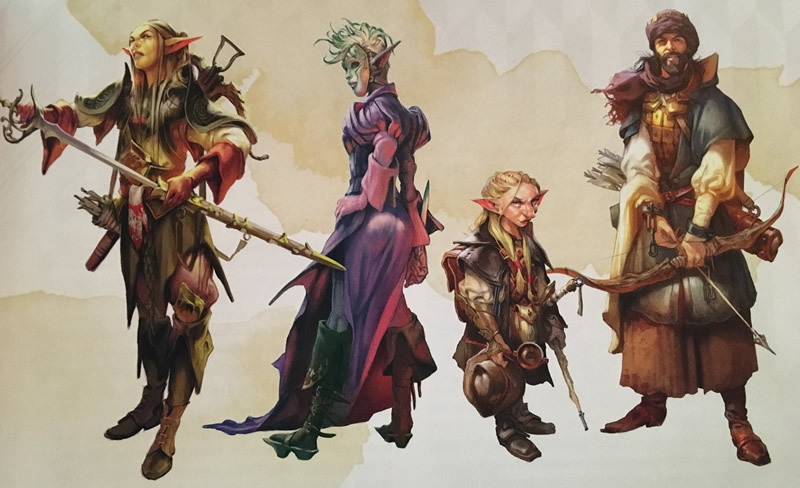
Rogue
Rogues can flesh out their backstory with a guilty pleasure, an adversary, and a benefactor. The rogue acquires two new archetypes and steals two others from the Sword Coast Adventurer’s Guide (SCAG):
- The Inquisitive is your chance to play Sherlock Holmes. Their sharp eye for detail and ability to read the true intent of creatures is useful in both investigations and combat.
- The Mastermind (also in SCAG) uses words as weapons and is a master of tactics, intrigue, manipulation and deceit.
- The Scout provides players with a chance to play a gritty wilderness survivalist and skirmisher, without having to be a ranger.
- The Swashbuckler (also in SCAG) is an expert duelist, who relies equally on speed, elegance and charm.
Sorcerer
Sorcerers can determine their arcane origin, reaction, supernatural mark, and sign of sorcery. The sorcerer gains two brand new origins and a reprint of Storm Sorcery:
- The Divine Soul is a blessed soul whose magic comes from a divine source, letting you a sorcerer who can draw from cleric spell lists.
- Shadow Magic lets you play a creature of shadow who draws their innate magic from the Shadowfell.
- Storm Sorcery (also in SCAG) lets you play a sorcerer whose magic comes from the power of elemental air, allowing control over wind and weather.
Warlock
A warlock is provided with ideas on how to detail their patron’s attitude, special terms of the pact, and a binding mark. The warlock made a deal with someone to gain two new otherworldy patrons:
- The Celestial lets you play a warlock whose holy pact is with a powerful being from the Upper Planes
- The Hexblade makes a pact with a mysterious entity from the Shadowfell, manifesting in a sentient magic weapon and letting you play a character powerful with both blade and spell.
The warlock also unlock two and half page of new eldritch invocations for a variety of pacts and levels.
Wizard
The wizard is provided with ways to add details about their spellbook, ambition, and eccentricities. The wizard adds one arcane tradition to the schools of magic found in the Player’s Handbook.
- War Magic is an arcane college that specializes in training wizards for war, blending evocation and adjuration. Those wizards who study the war magic tradition will learn techniques to empower their spells and bolster their defense.
This is Your Life
This section provides players with over 12 pages of ideas and random tables to expand their characters origin, background, class training, and life events. This backstory tool combined with the tables provided for each class, should be really helpful for players looking to create fully fleshed out characters. I had a chance to do a really dive into this section, you can read the full article here.
Racial Feats
There are 15 new racial feats. Each of the non-human races from the Player’s Handbook can select from two to four racial feats (some shared). Humans have been given to one feat called Prodigy (which I actually missed in my first read through of the book). The feats really enhance what makes a race unique, with halflings becoming luckier, dwarves getting tougher, dragonborn being even more draconic, tieflings more infernal, and so on.
CHAPTER 2: DUNGEON MASTER’S TOOLS
Chapter 2 provides a variety of tools that provide Dungeon Masters fresh ways to use traps, magic items, downtime activities, and more—all designed to enhance a D&D campaign and push it in new directions.
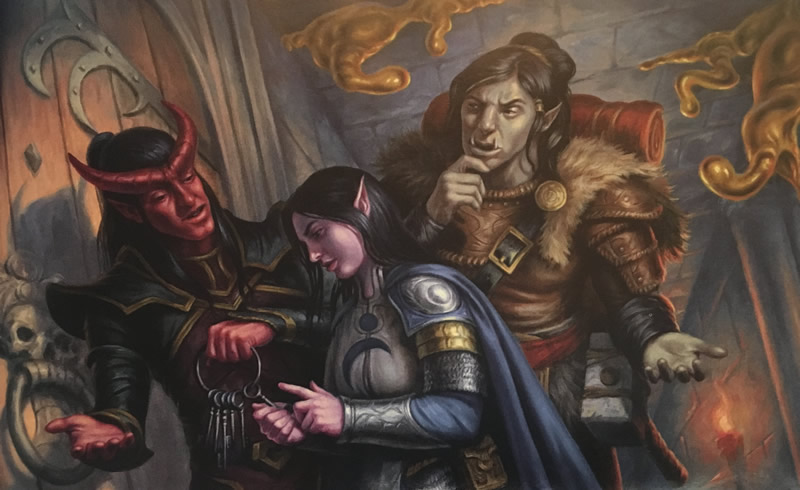
This chapter starts out with additional rules to handle falling, sleep, adamantine weapons, tying knots and tool proficiencies. The tool proficiencies expands on the tools section in the PHB, providing greater detail for each tool and lots direction on running skill checks for players using each tool. These are great little expansions to the rules. I tried out the tying knots rules in my last session, with my player rolling to see how good a knot he tied, which set the DC I would roll against if the captive goblins tried to escape.
The chapter then moves into spellcasting, looking at perceiving a caster at work, identifying spells, determining invalid spell targets, and providing greater detail for areas of effect on grids (using both words and images).
Encounter Building is a step by step guide on how to assess the power level of your PC, choose the correct encounter size and challenge rating, and then select monsters and add flavor to flesh out their personality and relationships. A quick match-up table is provided for each character level too.
Random Encounters has 21 pages of tables to create random encounters for any environment your players might find themselves traveling through. This section is very useful for any Dungeon Master (DM) who has struggled with how to handle the players wandering around the wilderness. Like the dungeon generator in the DMG, you could run a session just with these tables.
Traps Revisited provides DMs with tools to design and place simple and complex traps to challenge players at even higher levels. Example traps are provides with 9 simple traps and 3 complex traps. This is an excellent expansion of the so-so traps section of the Dungeon Masters Guide.
Downtime Revisited gives DMs over 11 pages of activities for players during downtime including creating rivals, buying magic items, carousing, crafting, crime, gambling, pit fighting, relaxing, religious services, researching, scribing spells, selling a magic item. This section is a gem and has already been bookmarked for the next visit into town.
Awarding Magic Items provides DMs with some handy ideas for how to distribute magic items by rarity, by tier, and by level. Magic items are also broken down into minor and major items, based on their power. One of the best parts of the book can be found here in the form of nearly fifty common magic items. These common magic items provide DMs with the ability to give out fun magic items that will do little to increase a player’s power. You’ll find cloaks that simply billow dramatically, clothes that mend themselves, and a hat that summons rats. The section closes out with almost a half dozen pages of tables listing magic items by rarity (split into minor and major).
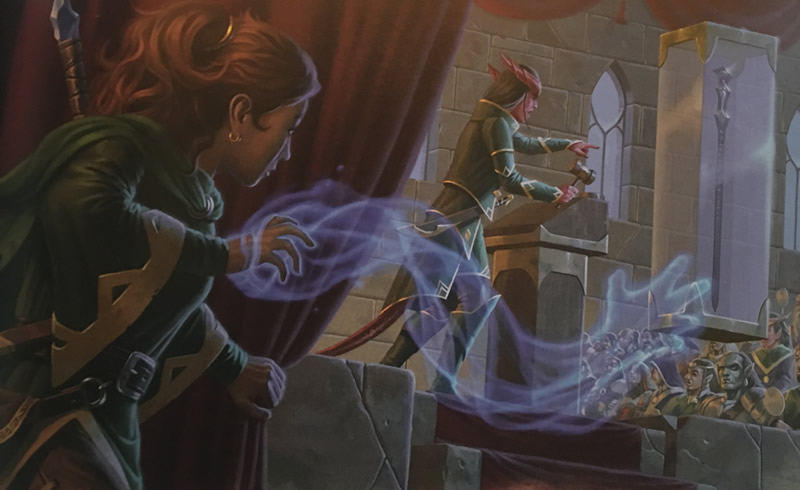
CHAPTER 3: SPELLS
Chapter 3 is the shortest of the three chapters, but it contains dozens of new spells (and reprinted/revised Elemental Evil spells) for every spellcasting class. There are 95 spells printed in this book and 56 of those spells are brand new. I think it is really handy to have almost all of the non PHB spells in one place, especially if you participate in Adventurer’s League and have to obey the PHB + 1 rule. Overall, the new spells are amazing and a great addition to the original spells. The bard, cleric, paladin and ranger are a little shortchanged, but the druid, sorcerer, warlock and wizard get a ton of new spells to choose from.You’ll find a good balance and variety of lower level and higher level spells.
If you are looking for Green flame blade and Booming blade, those spells from the Sword Coast Adventurer’s Guide were left out (along with the Bladesinger tradition). A few of the spells that stood out for me were Tiny servant (animates a tiny object such as a beer stein), Ceremony (great for cleric roleplaying of weddings, funerals), and Find greater steed (say hello to my pegasus, dire wolf, saber-tooth tiger or other awesome mount). Necromancers will be very happy, with new spells for most levels filling in gaps.

APPENDICES & OTHER STUFF
Overall, the appendices was the most disappointing part of the book.
In Appendix A, you’ll find a few pages on running a shared campaign. This really could have been a free PDF on the Adventurer’s League website, but maybe it was necessary to pull in new DMs to organized play.
In Appendix B, we are provided with 17 pages of random names for PCs, most of which are for humans from civilizations in our world. No human last names are provided and this content feels like filler. I feel like we lost out on what could have been 17 more pages of character options, dungeon master tools, and spells.
ADDED (January 2020): While I still agree that it would be nice to have human last names… this somehow is the section of the book (and all 5e books) I use the most. I was wrong. This is useful content when prepping and running my games. It has also come in handy when I am creating a PC. I take back this critique of the section.
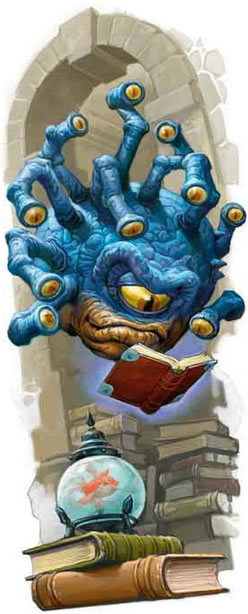
XANATHAR
Beauty is in the eye of the beholder, but evil is in its heart!
Assembled here for the first time is new information on adventurers of every stripe. In addition, you’ll find and valuable advice for those of nefarious intent who must deal with such meddling do-gooders, including the Xanathar’s personal thoughts on how to dispatch anyone foolish enough to interfere with his business dealings. Alongside observations on “heroes” themselves, the beholder fills the pages of this tome with his personal thoughts on tricks, traps, and even treasures and how they can be put to villainous use.
The title of the book makes it clear that this content is being provided to us by the beholder Xanathar. Throughout the book, Xanathar provides fun and strange little notes on the content. A few readers may find this humor a distraction, but I think it hits the mark. I’m happy the team continues the tradition started with their crazy disclaimers and continued in Volo’s Guide. Just to share a few notes from Xanathar:
- “Hexblade. What a cool name! So is your sword evil or cursed or something?“…
- “I always liked druids because they are made from natural ingredients. And I believe that everyone should have such a healthy diet.“
- To the horizon walker “You can’t walk to the horizon, because it keeps on getting further away. Boom! Did I just blow your mind? I did, didn’t I?“
CONCLUSION
After reading the book, I think this is an excellent expansion of both the Player’s Handbook and Dungeon Master’s Guide. I think it does way more things right, than wrong, but there are a few misses. It doesn’t try to do too much in its 200 pages, but nearly everything provided is a solid add to fifth edition.
- Of the 27 new classes, most are fun, exciting, or interesting to play. I found more than enough subclasses that I want to play and I enjoyed playing both the Scout and Arcane Archer in short sessions. The team did an overall good job on revising and adding to the Unearthed Arcana versions of the subclasses, finding a way to make sure each of them fit into the game.
- I really, really like all the backstory tools that were provided. I had a chance to go end to end and generate every aspect of a character, you can read it here.
- The Dungeon Master’s Tools are solid and there are some real standouts such as the common magic items.
- We get 56 new spells! Tell me something wrong with that?
- The appendices are a let down and I would rather see any other content than what was provided.
Xanathar’s Guide to Everything shows us that the team behind D&D is listening and learning as they go. While not perfect, this is a solid book and a worthy companion to the PHB and DMG.

Who Might Want to Avoid It?
- Anyone looking for Mass Combat rules
- Anyone looking for campaign setting details
- Anyone looking for artificers or psychic powered classes
- Newer DMs and players who aren’t 100% familiar (or bored) with the subclasses and spells found in the PHB
Who Should Buy It?
- Players and DMs looking for new spells for their heroes and big guys
- Experienced DMs looking for new ideas and materials for running their game
- Groups looking for new player options
- Players who want tools and ideas to fully flesh out their PCs
- DMs who like random tables
Let us know if the comments below what you think of this book or what content you are most excited about.
Need More Xanathar?
– Read our Preview of Xanathar’s Guide to Everything –
Disclaimer: I received a free review copy of the book from the publisher’s PR agency.


